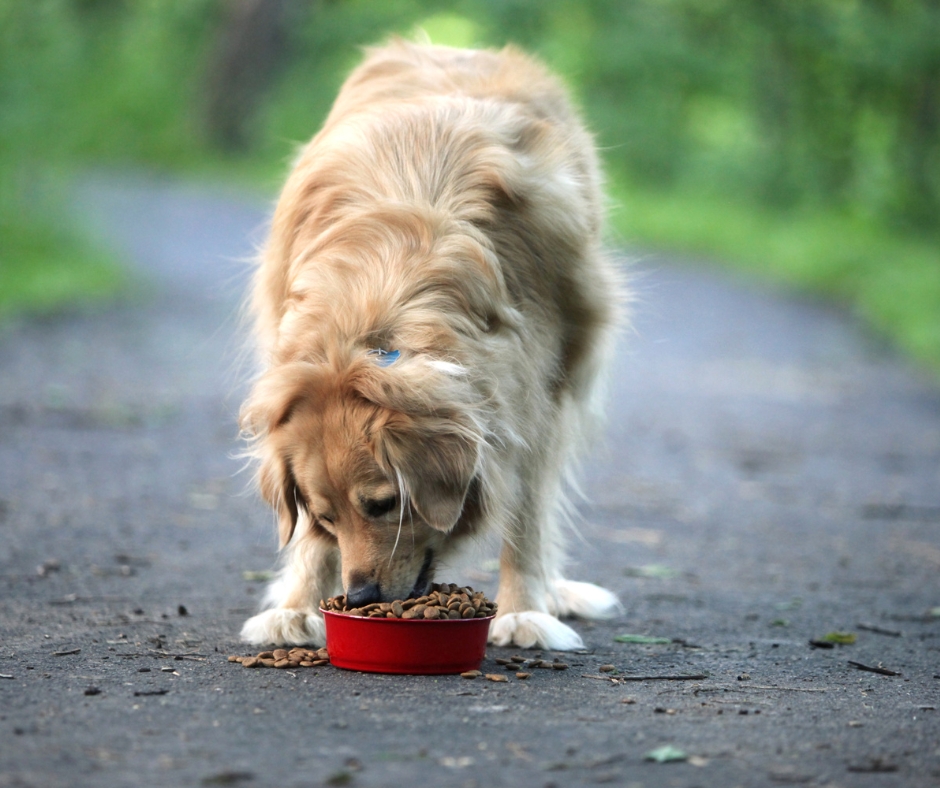Switch to an adult dog food guide when your dog is about a year old. For bigger breeds, waiting until 18 to 24 months may be essential.
It’s important for your dog’s health to go from puppy food to adult dog food. Puppies need more calories and protein to support their development and growth. Conversely, adult dogs need a diet that preserves their health without being too calorically dense.
Speaking with your veterinarian may help you determine whether to make the adjustment, depending on the breed, size, and health of your dog. The new diet may be introduced gradually to prevent digestive issues. This ensures a smooth transition and keeps your dog happy and healthy. A healthy diet is essential for your dog’s overall well-being.
An Overview of Dog Food for Adults
The switch to an adult dog food guide is an important turning point in your dog’s life. Due to their rapid development, puppies have varying nutritional needs. Knowing when to switch is vital for their well-being.
The Importance of It
Puppies and adult dogs need various nutritions. Food for puppies is high in calories and growth-promoting minerals. The nutrients in adult dog food are balanced to support good health.
Dogs who eat adult food have a lower chance of becoming obese. It improves their overall health and vigor.
| Age | Diet Needs |
|---|---|
| Puppy | High calories, protein, and fat |
| Adult | Balanced nutrients, lower calories |
Common Misconceptions
A common misconception is that dogs of various ages may eat together. This is a common miscommunication. Puppies need more calories and minerals to develop.
Another myth is that adult dog food is less appetizing. Adult food may be satisfying and delicious.
- Adults and puppies need different diets.
- Dog food for adults tastes just as good.
- Recognize the requirements and age of your dog.
- Around the age of one, switch to adult meals.
Signs That Your Dog Is All Set
Knowing when to switch your puppy to adult dog food guide is crucial. It ensures they get the right nutrients for growth. Here are a few signs that your puppy may be ready for this transition.
Physical Maturity
One important factor is maturity physically. Puppies typically reach physical development between the ages of 12 and 24 months. The development of smaller breeds takes about a year. For bigger breeds, it might take up to 24 months. Check your puppy’s weight and development. If they’ve reached adult size, it’s time to consider switching.
| Breed Size | Age of Maturity |
|---|---|
| Small Breeds | 12 Months |
| Medium Breeds | 18 Months |
| Large Breeds | 24 Months |
Changes in Behavioral
Changes in behavior also indicate preparedness. Puppies need more nourishment than adults do. Their growth is slower. It could be time if your puppy starts playing more and eating less.
- They are no longer as interested in puppy food.
- They are more active and play more.
- They have better bladder control.
Keep a close eye on your puppy’s behavior. When converting to adult dog food, you might refer to these modifications. Making the transition gradually may help to avoid intestinal problems. The new food should be introduced gradually over a week. Add a little amount of adult food to their regular puppy food. Increase the quantity of grownup food you eat each day. By the week’s end, your dog will be fully transitioned.
Differences in Nutrition
It’s critical to comprehend how puppy and adult dog food vary nutritionally. Adult dogs need a maintenance diet; however, puppies need additional nutrients for development. Your dog’s health will benefit from a timely transition to adult dog food.
Adult vs. Puppy Food
Puppy food is meant to encourage rapid growth. It has more protein and fat. Maintenance of weight and health is the aim of adult dog food. The nutritional levels of an adult dog are balanced.
Important Nutrients
The primary nutrients included in puppy and adult dog chow are as follows:
| Nutrient | Puppy Food | Adult Dog Food |
|---|---|---|
| Protein | Higher for muscle development | Moderate for maintenance |
| Fat | Higher for energy | Balanced for weight control |
| Calcium | More for bone growth | Enough for bone health |
| Calories | Higher for growth | Controlled for adult needs |
Puppies gain strength and health as a result of these nutrients. Adult dogs need a balanced diet to be healthy and active. Before making any dietary adjustments, speak with your veterinarian.
Selecting the right Adult Dog Food
One important step is to switch your dog to adult dog food. It guarantees that they get the proper nutrients for their new phase of development. It might be difficult to choose the best adult dog food. How do you choose when there are so many options? Let’s simplify and clarify the procedure by breaking it down.
Ingredients To Look For
The first component should be high-quality proteins. Try to find fish, meat, or chicken. These proteins promote general health and help preserve muscular mass.
Oatmeal and brown rice are great examples of whole grains. They are simple to digest and provide you energy. Vitamins and minerals may be found in vegetables like peas and carrots.
It’s essential to get healthy fats from foods like flaxseed or fish oil. They promote the health of the skin and coat. Blueberries and other fruits contain antioxidants that strengthen the immune system.
| Ingredient | Benefits |
|---|---|
| High-quality proteins | Maintain muscle mass |
| Whole grains | Provide energy, easy to digest |
| Vegetables | Vitamins and minerals |
| Healthy fats | Support skin and coat health |
| Antioxidants | Boost the immune system |
Avoid using fillers
Fillers are substances that provide bulk but have little nutritional value. Avoid items that include maize, soy, or wheat as main ingredients. Allergies and gastrointestinal issues may arise from them.
Choose meals devoid of artificial coloring, flavoring, and preservatives. These components may be harmful to your dog’s health. Natural preservatives that are safer include vitamins E and C.
Examine the ingredient list carefully. The first five are the most important. Verify that they are high-quality and free of fillers.
- Avoid corn
- Avoid soy
- Avoid wheat
- No artificial preservatives
- No artificial colors
- No artificial flavors
By keeping an eye on these variables, you can ensure that your dog is receiving the best possible diet. This keeps them occupied and healthy as adults.
The Transition Process
When your dog begins eating adult food, it’s a significant turning point in their lives. Throughout the process, caution should be used to avoid digestive issues. Let’s look at the transitioning procedure to ensure a smooth transfer.
The Gradual Switching Method
Changing your dog’s food gradually is vital. Start by adding a little amount of adult food to what they are already consuming. Increase the amount of grownup food eaten each day.
- Day 1-3: 25% adult food, 75% puppy food
- Day 4-6: 50% adult food, 50% puppy food
- Day 7-9: 75% adult food, 25% puppy food
- Day 10: 100% adult food
By introducing the new diet gradually, you can help your dog adjust and prevent stomach problems.
Examining Your Dog
It’s crucial to watch your dog throughout the transition. Watch out for any signs of gastrointestinal issues, such as:
- Vomiting
- Diarrhea
- Loss of appetite
If any of these symptoms appear, slow down the changeover. Ensure that your dog has access to clean water at all times.
You may also keep an eye on their weight and energy levels. A healthy dog maintains their weight and stays active.
Consult your veterinarian if you notice any changes that appear concerning. They could provide guidance depending on your dog’s needs.

Specific Things to Keep in Mind
It’s a significant step to start your Switch to an adult dog food guide. Understanding the special characteristics is necessary to guarantee a smooth transition. This section goes into great length on important topics, including breed-specific needs and health issues.
Requirements Specific to Breeds
Different dog breeds need different diets. For instance, large breeds like Labradors need diets that support healthy joints. Small breeds like chihuahuas may need calorie-dense diets.
The following short table illustrates several breed-specific requirements:
| Breed Type | Dietary Requirement |
|---|---|
| Large Breeds | Joint support, moderate calories |
| Small Breeds | Calorie-dense, smaller kibble size |
| Active Breeds | High protein, higher fat content |
Health Conditions
Certain medical conditions can influence dietary needs. For dogs with allergies, grain-free diets could be required. Overweight dogs should consume fewer fat and calories.
Here are some examples of how medical issues affect nutrition:
- Allergies: Foods for allergies that are hypoallergenic or grain-free
- Obesity: Low-fat, low-calorie diet
- Diabetes: Foods rich in fiber and low in sugar
Consult your veterinarian for detailed instructions on converting to adult dog food in light of these particular circumstances.
Common Mistakes To Avoid
Making the switch to grownup meals is a crucial first step. Many pet owners make mistakes during this transition. You can maintain the health of your dog by being aware of these mistakes.
Changing Too Soon
One common mistake is switching to adult food too soon. Puppies need certain nutrients to develop. Adult meals lack these essential components.
- Puppies need more protein and calories.
- Vitamin deficiencies may occur in puppies fed adult food.
- Make the transition only if your veterinarian suggests it.
If puppies are moved too soon, they may have health issues. You should always consult your veterinarian before making a transition.
Ignoring Changes in Weight
Ignoring your dog’s weight fluctuations is another error. Weight gain or loss may be a sign of dietary problems.
| Weight Change | Possible Cause | Action |
|---|---|---|
| Weight Gain | Too many calories | Reduce food intake |
| Weight Loss | Not enough nutrients | Increase food intake |
Regularly check your dog’s weight. Adapt their diet to variations in weight. If you have any concerns, always see your veterinarian.

Speaking with Your Veterinarian
It’s a significant step to start feeding your dog adult food. It’s important to speak with your veterinarian at this time. Your veterinarian can provide you with professional guidance specific to your dog’s requirements.
Professional Advice
Your veterinarian is aware of your dog’s medical history. They may provide customized nutrition recommendations. Among the factors they consider are breed, size, and health. This ensures that switching to adult dog food will go smoothly.
| Factor | Consideration |
|---|---|
| Breed | Some breeds have specific dietary needs |
| Size | Small, medium, and large breeds mature at different rates |
| Health Conditions | Conditions like allergies or obesity affect food choices |
Routine Check-ups
Regular veterinarian attention is required. They monitor the growth and health of your dog. During these tests, talk about switching to adult dog food. Your veterinarian may advise you on the ideal time to transition.
- Monitor your progress and weight.
- Check for any health issues.
- Revise your vaccination and food regimens.
Frequent exams help identify any problems early on. They ensure that your dog stays healthy during the transition. Always follow your veterinarian’s advice for the best results.
Maintaining A Balanced Diet
Make sure your dog’s diet is balanced for their health. One important step is moving from switch to an adult dog food guide. This modification maintains their energy levels and overall well-being. These are some crucial subjects to focus on.
Regular Feeding Schedule
Maintaining a regular eating schedule is crucial. Adult canines thrive on routine. Every day, feed your dog at the same times. This enhances digestion and energy levels.
This is a simple feeding schedule that you may follow:
| Time | Meal |
|---|---|
| 7:00 AM | Breakfast |
| 12:00 PM | Lunch (optional) |
| 6:00 PM | Dinner |
Supplementation Options
There may be instances when your dog needs more food. Supplements may be used to make up for any nutritional deficiencies they may have. Common supplements include:
- Skin and coat health depend on omega-3 fatty acids.
- Glucosamine: helps keep joints healthy.
- Probiotics are digestive helpers.
Prior to taking any supplements, a veterinarian should be contacted. They may recommend options that are best suited to your dog’s needs.

Frequently Asked Questions
When Can I Switch to Adult Dog Food?
You should switch to adult dog food when your dog is around a year old. There may be breed-specific variations in this.
How Do I Go About Changing to Adult Dog Food?
Slowly mix the new and old meals together over a week. Increase the amount of adult food each day.
Why Is Adult Dog Food Superior?
Adults and puppies need different diets. It promotes maintenance rather than growth.
What happens if you don’t switch?
If you don’t make the change, your dog may gain weight or miss out on vital nutrients. A nutritious diet is crucial.
In conclusion
Making the transition to adult dog food is crucial for your dog’s development and health. Consult a veterinarian and monitor your dog’s progress to choose the best time. If you give your pet the right food, they will live a long, healthy life.
For your optimal health, be educated and make sure the transition goes well.










